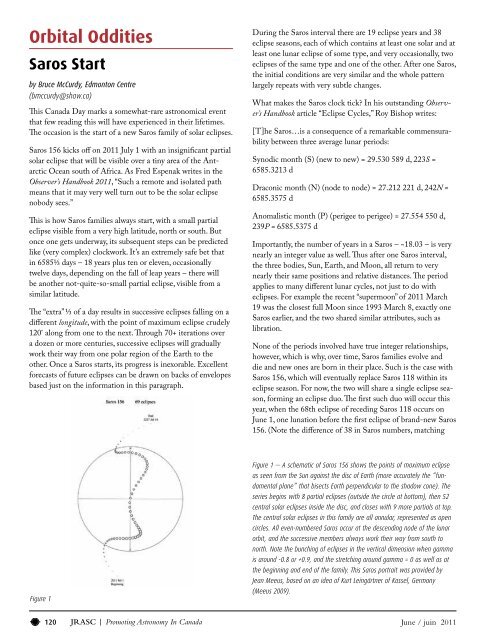The Running Man Nebula
The Running Man Nebula - The Royal Astronomical Society of ...
The Running Man Nebula - The Royal Astronomical Society of ...
You also want an ePaper? Increase the reach of your titles
YUMPU automatically turns print PDFs into web optimized ePapers that Google loves.
Orbital OdditiesSaros Startby Bruce McCurdy, Edmonton Centre(bmccurdy@shaw.ca)This Canada Day marks a somewhat-rare astronomical eventthat few reading this will have experienced in their lifetimes.<strong>The</strong> occasion is the start of a new Saros family of solar eclipses.Saros 156 kicks off on 2011 July 1 with an insignificant partialsolar eclipse that will be visible over a tiny area of the AntarcticOcean south of Africa. As Fred Espenak writes in theObserver’s Handbook 2011, “Such a remote and isolated pathmeans that it may very well turn out to be the solar eclipsenobody sees.”This is how Saros families always start, with a small partialeclipse visible from a very high latitude, north or south. Butonce one gets underway, its subsequent steps can be predictedlike (very complex) clockwork. It’s an extremely safe bet thatin 6585⅓ days – 18 years plus ten or eleven, occasionallytwelve days, depending on the fall of leap years – there willbe another not-quite-so-small partial eclipse, visible from asimilar latitude.<strong>The</strong> “extra” ⅓ of a day results in successive eclipses falling on adifferent longitude, with the point of maximum eclipse crudely120 º along from one to the next. Through 70+ iterations overa dozen or more centuries, successive eclipses will graduallywork their way from one polar region of the Earth to theother. Once a Saros starts, its progress is inexorable. Excellentforecasts of future eclipses can be drawn on backs of envelopesbased just on the information in this paragraph.During the Saros interval there are 19 eclipse years and 38eclipse seasons, each of which contains at least one solar and atleast one lunar eclipse of some type, and very occasionally, twoeclipses of the same type and one of the other. After one Saros,the initial conditions are very similar and the whole patternlargely repeats with very subtle changes.What makes the Saros clock tick? In his outstanding Observer’sHandbook article “Eclipse Cycles,” Roy Bishop writes:[T]he Saros…is a consequence of a remarkable commensurabilitybetween three average lunar periods:Synodic month (S) (new to new) = 29.530 589 d, 223S =6585.3213 dDraconic month (N) (node to node) = 27.212 221 d, 242N =6585.3575 dAnomalistic month (P) (perigee to perigee) = 27.554 550 d,239P = 6585.5375 dImportantly, the number of years in a Saros – ~18.03 – is verynearly an integer value as well. Thus after one Saros interval,the three bodies, Sun, Earth, and Moon, all return to verynearly their same positions and relative distances. <strong>The</strong> periodapplies to many different lunar cycles, not just to do witheclipses. For example the recent “supermoon” of 2011 March19 was the closest full Moon since 1993 March 8, exactly oneSaros earlier, and the two shared similar attributes, such aslibration.None of the periods involved have true integer relationships,however, which is why, over time, Saros families evolve anddie and new ones are born in their place. Such is the case withSaros 156, which will eventually replace Saros 118 within itseclipse season. For now, the two will share a single eclipse season,forming an eclipse duo. <strong>The</strong> first such duo will occur thisyear, when the 68th eclipse of receding Saros 118 occurs onJune 1, one lunation before the first eclipse of brand-new Saros156. (Note the difference of 38 in Saros numbers, matchingFigure 1Figure 1 — A schematic of Saros 156 shows the points of maximum eclipseas seen from the Sun against the disc of Earth (more accurately the “fundamentalplane” that bisects Earth perpendicular to the shadow cone). <strong>The</strong>series begins with 8 partial eclipses (outside the circle at bottom), then 52central solar eclipses inside the disc, and closes with 9 more partials at top.<strong>The</strong> central solar eclipses in this family are all annular, represented as opencircles. All even-numbered Saros occur at the descending node of the lunarorbit, and the successive members always work their way from south tonorth. Note the bunching of eclipses in the vertical dimension when gammais around -0.8 or +0.9, and the stretching around gamma = 0 as well as atthe beginning and end of the family. This Saros portrait was provided byJean Meeus, based on an idea of Kurt Leingärtner of Kassel, Germany(Meeus 2009).120 JRASC | Promoting Astronomy In Canada June / juin 2011
















